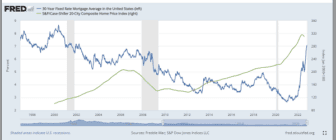
I have been hearing news reporters and commentators say: “…the Fed raised ‘the rate,’” over and over, as if there is a single interest that the Fed has the power to control.
As a related aside, borrowers also often ask us: “What is your rate?” – as if there is one rate for borrowers too, when there are as many as 13 different factors that affect an individual borrower’s rate.
Anyway – the purpose of this blog is to explain that there is no one rate in the broader world of finance too.
While all of us in real estate and mortgages focus exclusively on mortgage interest rates, the rest of the world focuses on a variety of different interest rates – and they do not all move in unison.
There are numerous interest rates that economists and investors observe, including:
- The 10 Year Treasury Yield – This is probably the most important of the major rate indicators, as it shows what it costs the U.S. Government to borrow at any given time and because 10 Year treasuries represent the most popular reserve asset in the world. 10 Year yields dropped close to 0.5% in 2020 and are now close to 2.4%. Mortgage rates largely move in unison with the 10 Year yields, but not always; in recent months, mortgage rates have climbed almost 2% while the 10 Year has increased by only about 1%.
- The Prime Rate – This is the rate the banks charge their best corporate clients, and it is the rate most Home Equity Lines of Credit (HELOCS) are tied to. Prime Rate is 3.5% today, up from 3.25% a few weeks ago, but down from 4.75% as recently as 2018. It was over 8% in the 1990s and at 20% in 1980.
- The Fed Funds Rate – This is the primary rate that the Federal Reserve uses to influence interest rates overall by increasing or decreasing that rate in an effort to stimulate or slow down the economy. The Fed Funds Rate is also the rate that banks charge each other when they have to borrow overnight to pad their required “reserves.” It is a very short-term rate, and it does not always influence long-term rates in the way the Fed would like. The Fed Funds Rate is currently at 0.5%, up from 0.25% prior to the Fed’s recent rate increase. It has hovered near zero though since the 2008 financial crisis.
- Mortgage-Backed Security (MBS) Yields – Most mortgages are bundled into giant “pools,” packaged as securities and then sold on the secondary market as MBS to investors. What these investors end up paying for these MBS reflects the actual yield. Over the last ten years, the yield from the MBS has been a little over 2% higher than 10 Year Treasury Yields on average. MBS yields are higher than 10 Year Treasury yields because MBS are considered riskier – both from a default and a likelihood of early pay-off perspective.
- Average Mortgage Rates – These are the average rates that individual borrowers get (from direct lenders) when they take out a mortgage before the mortgage is sold to investors. Mortgage News Daily does the best job of tracking these averages. It should be noted that jumbo rates remain about 1/2% lower than conforming (Fannie/Freddie) rates too.
Note: My descriptions above are oversimplified for brevity’s sake, and I am using “yield” and “interest rate” interchangeably, although they are not exactly the same.
The 10 Year Treasury Yield, the Prime Rate, the Fed Funds Rate, MBS Rates, and mortgage rates usually move in unison, but sometimes they do not.
For example, there have been instances where reductions in the Fed Funds rate actually resulted in higher mortgage rates because the market perceived the reduction in the Fed Funds rate as stimulative or as a boon to the economy – which often pushes rates up.
And increases in the Fed Funds Rate can push mortgage rates down when such increases are perceived as inflation-fighting efforts or recession threats.
Jay Voorhees
Founder/Broker | JVM Lending
(855) 855-4491 | DRE# 1197176, NMLS# 310167
























